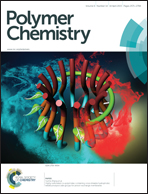Alkylidenefluorene–isoindigo copolymers with an optimized molecular conformation for spacer manipulation, π–π stacking and their application in efficient photovoltaic devices†
Abstract
D–(π)n-A-type copolymers with different thienyl spacers (n = 0–2) between alkylidenefluorene and isoindigo (P1, P2, P3) were synthesized via a Suzuki coupling reaction. As the number of spacers was increased in a polymer (P1), the UV-Vis absorption maximum (λmax) red-shifted, and the band gap decreased from 1.83 to 1.64 eV. The highest occupied molecular orbital (HOMO) levels of the polymers were increased by increasing the number of spacers. In addition, the facile intermixing due to better accessibility with the PCBM led to an increase in the hole mobility and JSC. In contrast to P1 and P2, when the P3 thin films were blended with PC70BM in the X-ray diffraction (XRD) measurement, an increased face-on structure of the crystal was observed. The power conversion efficiency (PCE) of P3 was 3.0% and it reached 4.2% for the inverted device fabricated at 1 : 2 ratio with PC70BM.


 Please wait while we load your content...
Please wait while we load your content...